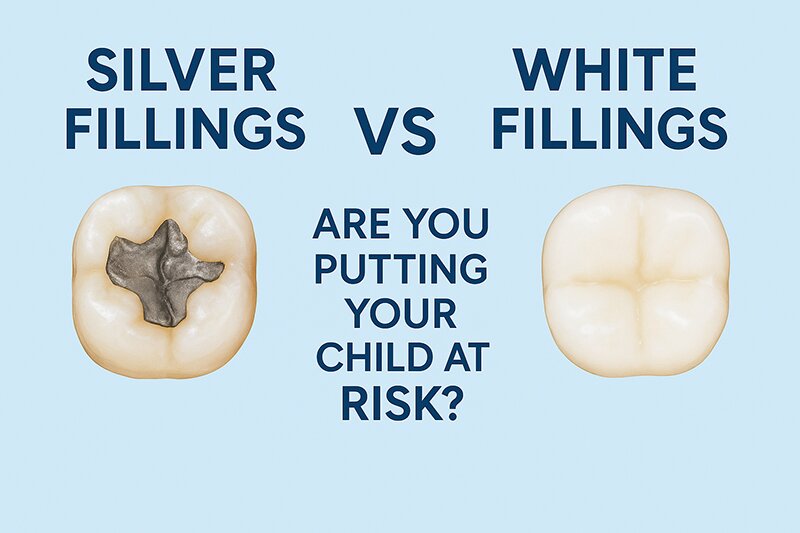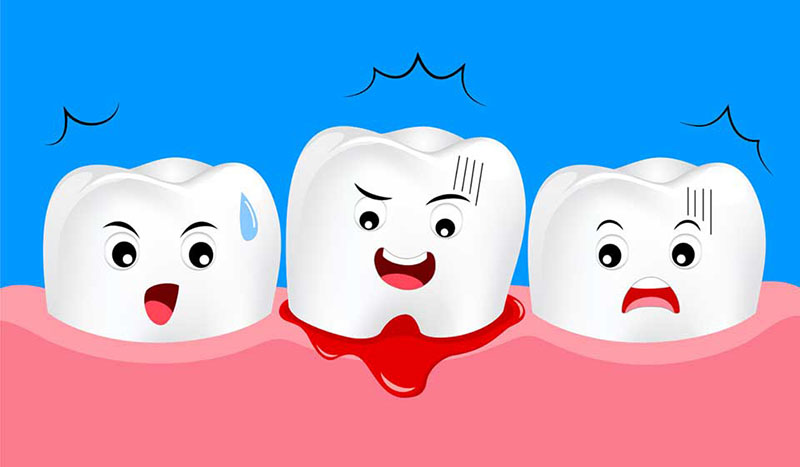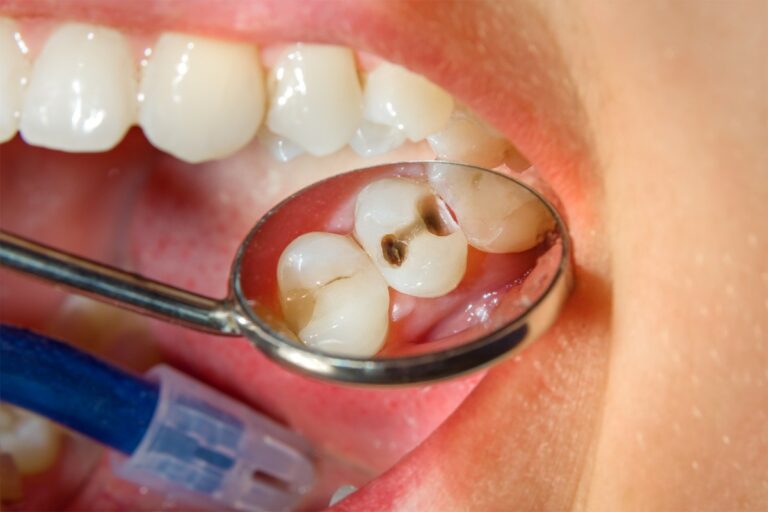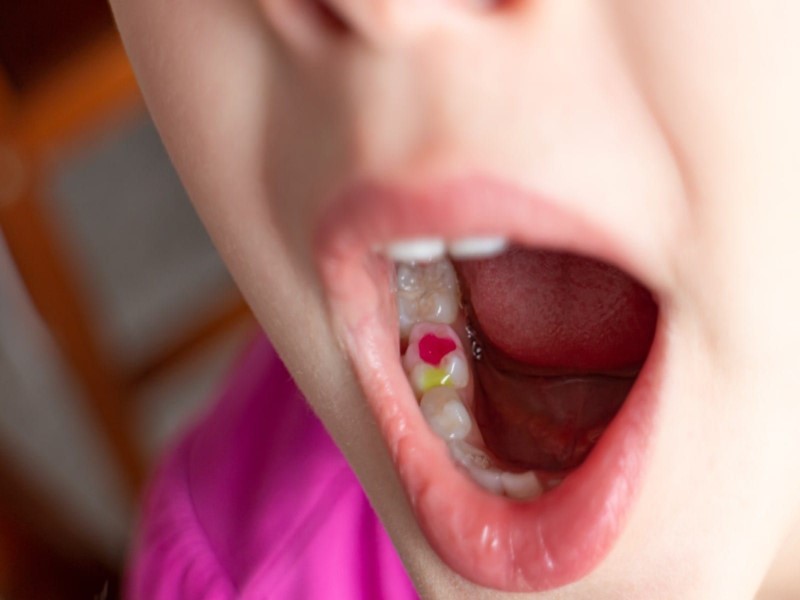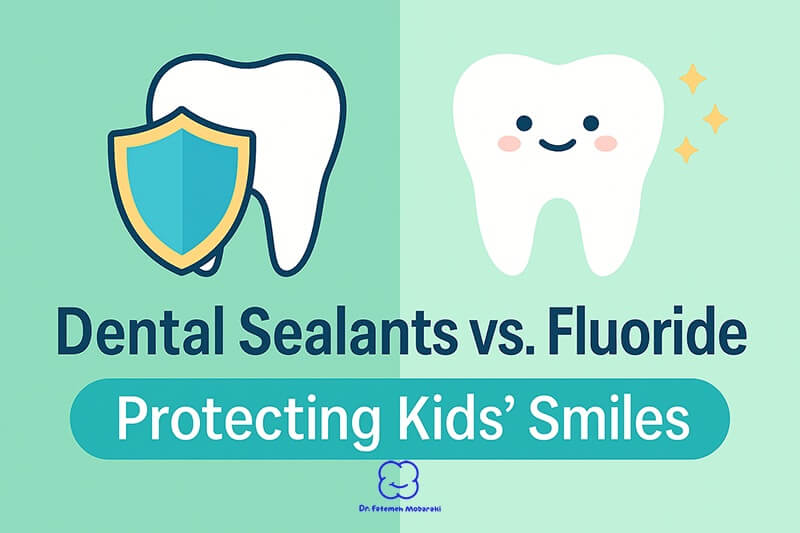When it comes to your child’s dental health, you want to make the best decisions possible. One common question many parents ask is: “Should I choose silver fillings or white fillings for my child?” Both options are safe and effective, but they differ in terms of appearance, durability, cost, and suitability depending on your child’s specific needs. In this guide, we’ll break down everything you need to know about silver fillings vs white fillings to help you make an informed decision.
What Are Dental Fillings and Why Do Kids Need Them?
Dental fillings for kids are used to restore teeth damaged by cavities. In children, tooth decay can progress quickly due to thinner enamel and sugary diets. If left untreated, cavities can lead to pain, infection, and even damage to adult teeth developing underneath.
Fillings prevent further decay and restore the tooth’s function. But the big question is: which type of filling is right for your child?
What Are Silver Fillings? Pros, Cons & When to Use Them
Silver fillings, also known as amalgam fillings, are made from a mix of metals including silver, tin, copper, and mercury. They’ve been used in dentistry for over 150 years.
Pros of Silver Fillings:
- Durable: They last 10-15 years or more.
- Cost-effective: Generally less expensive than white fillings.
- Strong under pressure: Ideal for molars where chewing forces are greatest.
- Less sensitive to moisture: Easier to place in younger children who may struggle to sit still.
Cons of Silver Fillings:
- Noticeable appearance: Their metallic color contrasts with natural tooth enamel.
- Potential for minor cracking: Metal expands and contracts with temperature changes.
- Contains mercury: Although in a stable form and considered safe by major dental associations, some parents prefer mercury-free options.
What Are White Fillings for Kids? Benefits & Drawbacks
White fillings, or composite resin fillings, are made from a mixture of plastic and glass materials. They are tooth-colored and can be matched closely to your child’s natural tooth shade.
Pros of White Fillings:
- Aesthetically pleasing: Blends in with natural teeth.
- Mercury-free: A safer-feeling option for concerned parents.
- Preserves more of the tooth: Bonds directly to the tooth surface, requiring less removal of healthy tooth structure.
- Versatile: Suitable for both front and back teeth.
Cons of White Fillings:
- Less durable: May last 5-7 years, especially on molars.
- Slightly higher cost: Usually more expensive than amalgam.
- Technique-sensitive: Requires a dry environment and precise placement, which can be harder with younger kids.
Silver vs White Fillings for Kids: A Visual Comparison
To make things even clearer, let’s look at a side-by-side comparison highlighting the most important differences between silver and white fillings for children.
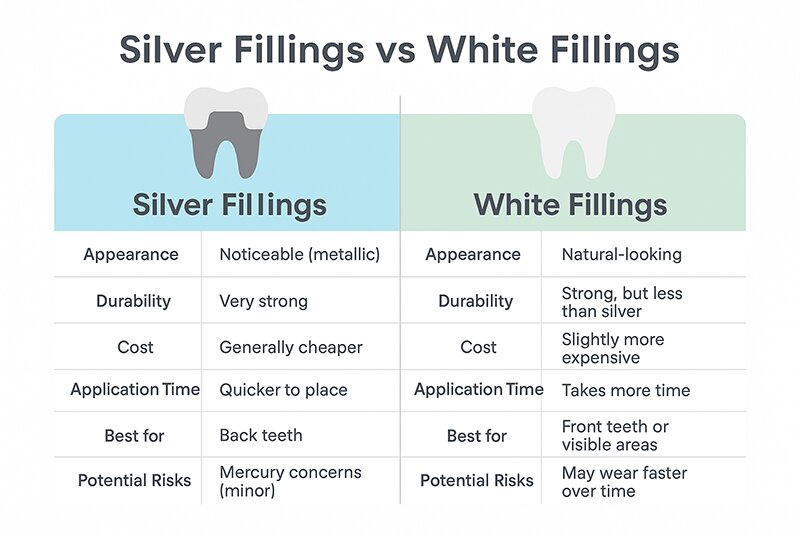
Are Silver Fillings Safe for Children?
This is a common concern for parents. While silver fillings do contain mercury in a stable alloy form, extensive research by the American Dental Association (ADA), U.S. Food and Drug Administration (FDA), and the World Health Organization (WHO) has shown that amalgam fillings are safe for children over six.
However, for younger children or those with specific health conditions, many dentists recommend white fillings as a more modern, mercury-free option.
Best Situations for Choosing White Fillings in Children
White fillings are a great choice when:
- The cavity is in a visible area, such as front teeth.
- Your child is older and can sit still during a longer procedure.
- You prefer an aesthetic or mercury-free solution.
- The cavity is small or moderate in size.
Modern advancements have improved the strength of composite fillings, making them more reliable even for back teeth in many cases.
When to Choose Silver Fillings for Your Child’s Teeth
Silver fillings are ideal when:
- The decay is in back molars, where strength matters most.
- Your child is very young or restless, and the procedure needs to be quicker.
- Budget is a consideration.
- Moisture control is difficult (silver fillings are less sensitive to a wet environment).
What Do Pediatric Dentists Say About White vs Silver Fillings?
Some dentists suggest using silver fillings on baby molars that will fall out eventually and white fillings on permanent or visible teeth. in Dubai and globally offer both options and recommend based on:
- Tooth location
- Extent of decay
- Age and cooperation level of the child
- Parental preference
Dr. Mobaraki, a pediatric dental specialist, explains:
“In most cases, we recommend white fillings for visible teeth due to their natural appearance, and silver fillings for back molars in very young or uncooperative children because they’re quicker to place and extremely durable.”
Should You Replace Old Silver Fillings with White Ones?
Unless there is a problem with the existing silver filling (like a crack or decay underneath), most dentists advise not replacing them unnecessarily. However, if your child has an allergy, sensitivity, or aesthetic concern, it may be worth discussing with your dentist.
Silver vs White Fillings Cost in Dubai
In general, silver fillings are more affordable than white fillings. However, many parents opt for white fillings despite the slightly higher cost because of their cosmetic advantage and mercury-free composition.
In Dubai, insurance coverage varies. Some insurance plans may fully cover silver fillings for children, while composite (white) fillings may only be partially covered or not covered at all. It’s important to check your policy and consult your dentist about expected costs.
How to Care for Silver or White Fillings in Children
To help your child’s fillings last as long as possible, follow these care tips:
- Encourage good brushing habits twice a day with fluoride toothpaste.
- Schedule regular dental check-ups every 6 months.
- Limit sugary snacks and drinks.
- If your child grinds their teeth, ask your dentist about a mouthguard.
- Teach your child to avoid chewing on hard objects like ice or pens.
Proper kids oral hygiene and regular visits to the dentist help monitor the condition of the fillings and catch any issues early.
How We Help You Choose the Right Filling for Your Child
At our pediatric dental clinic in Dubai, we prioritize both function and aesthetics. We offer:
- Both silver and white filling options
- Expert consultation to help parents decide
- Child-friendly techniques to ensure a stress-free experience
- Modern technology to minimize treatment time and maximize comfort
- Clear cost breakdowns and help with insurance inquiries
- A warm, welcoming environment designed just for kids
We guide every parent with compassion and clarity to ensure the best outcome for your child’s oral health.
White or Silver Fillings: Which Is Best for Your Child?
There is no universal answer. The best choice depends on your child’s individual situation. Both silver and white fillings are effective and safe. Your pediatric dentist can help you choose what works best based on tooth position, cavity size, and your personal preferences.
What matters most is that cavities are treated early to prevent pain and protect your child’s smile.
Ready to Book a Consultation?
Whether you’re considering silver fillings vs white fillings, our team is here to help. Contact our Dubai clinic today to schedule a consultation. Let’s protect your child’s smile with care, comfort, and the latest in pediatric dental solutions.
Frequently Asked Questions (FAQs)
1. Are white fillings as strong as silver ones?
White fillings have improved significantly in strength and are now suitable for many back teeth, but silver is still considered stronger for large cavities.
2. Will my child feel pain during the filling procedure?
No. We use local anesthesia to ensure your child is comfortable and pain-free.
3. Do white fillings stain over time?
White fillings may discolor slightly with age, especially if your child consumes a lot of colored drinks or foods, but proper oral care helps prevent this.
4. Can my child eat right after getting a filling?
It’s best to wait until the numbness wears off to avoid accidental biting. Soft foods are recommended for the first few hours.
5. How do I know if my child needs a filling?
If your child complains of tooth pain, sensitivity, or you notice dark spots or holes, schedule a check-up promptly.

